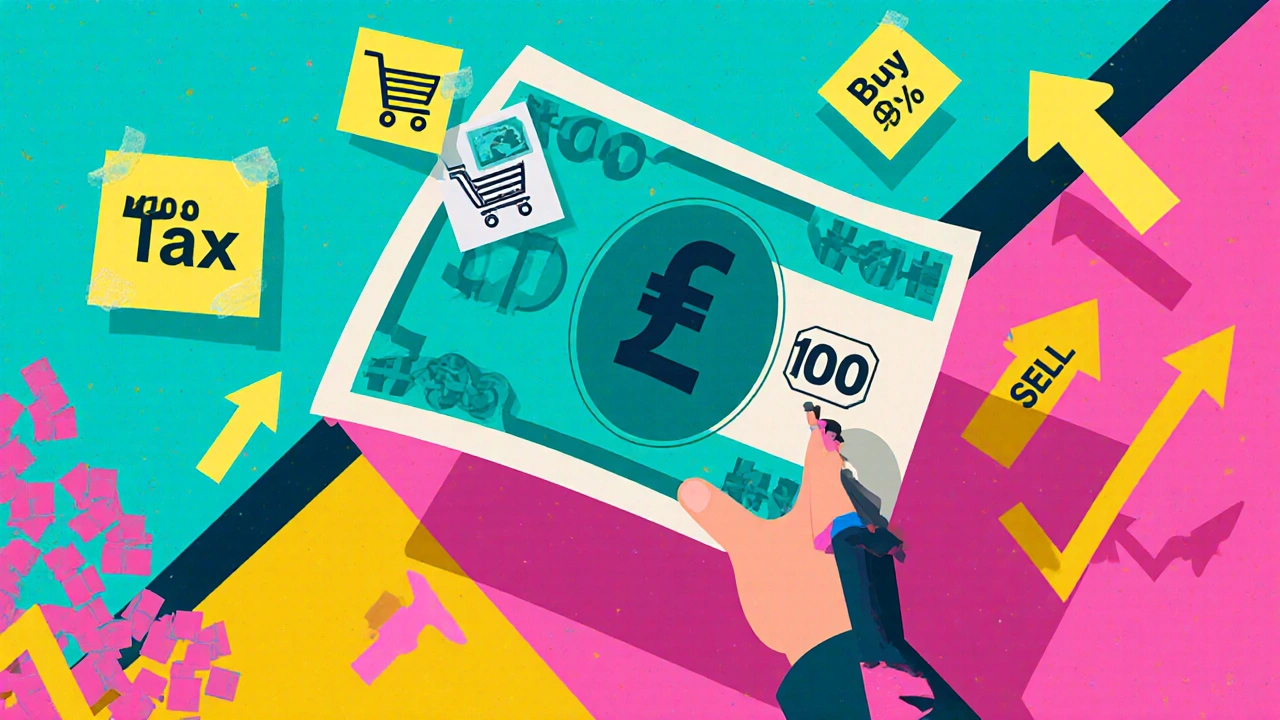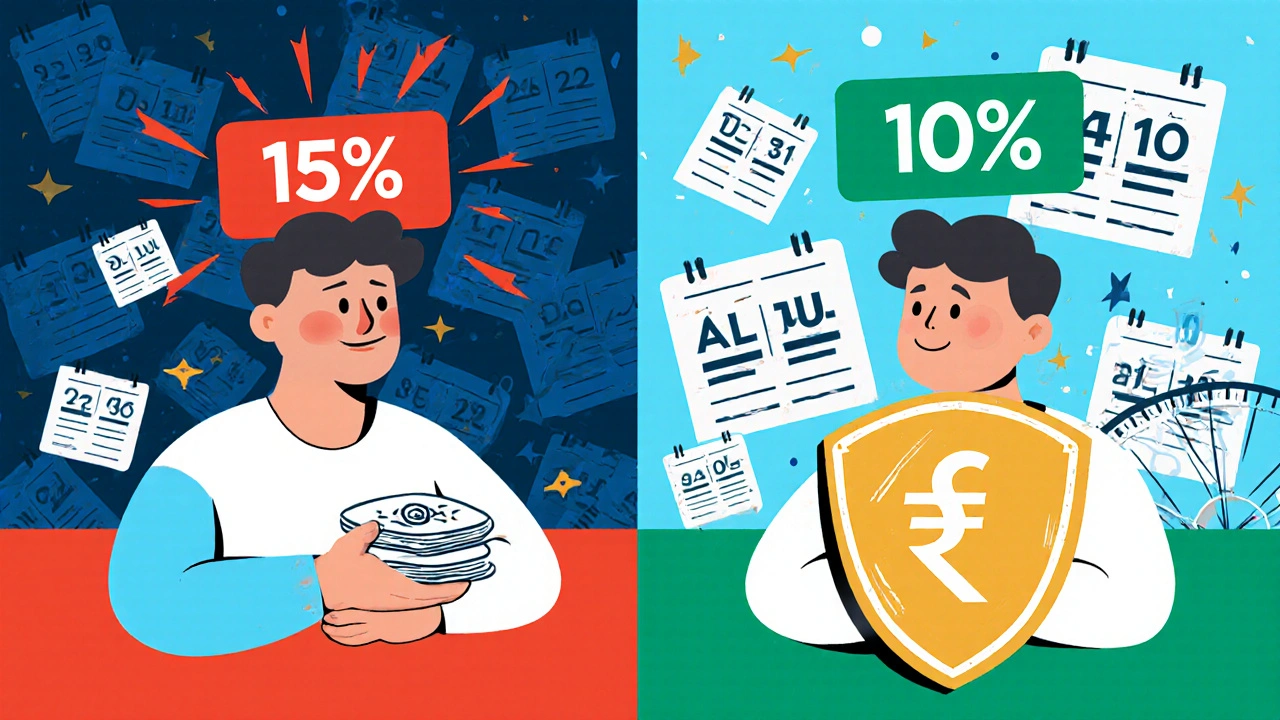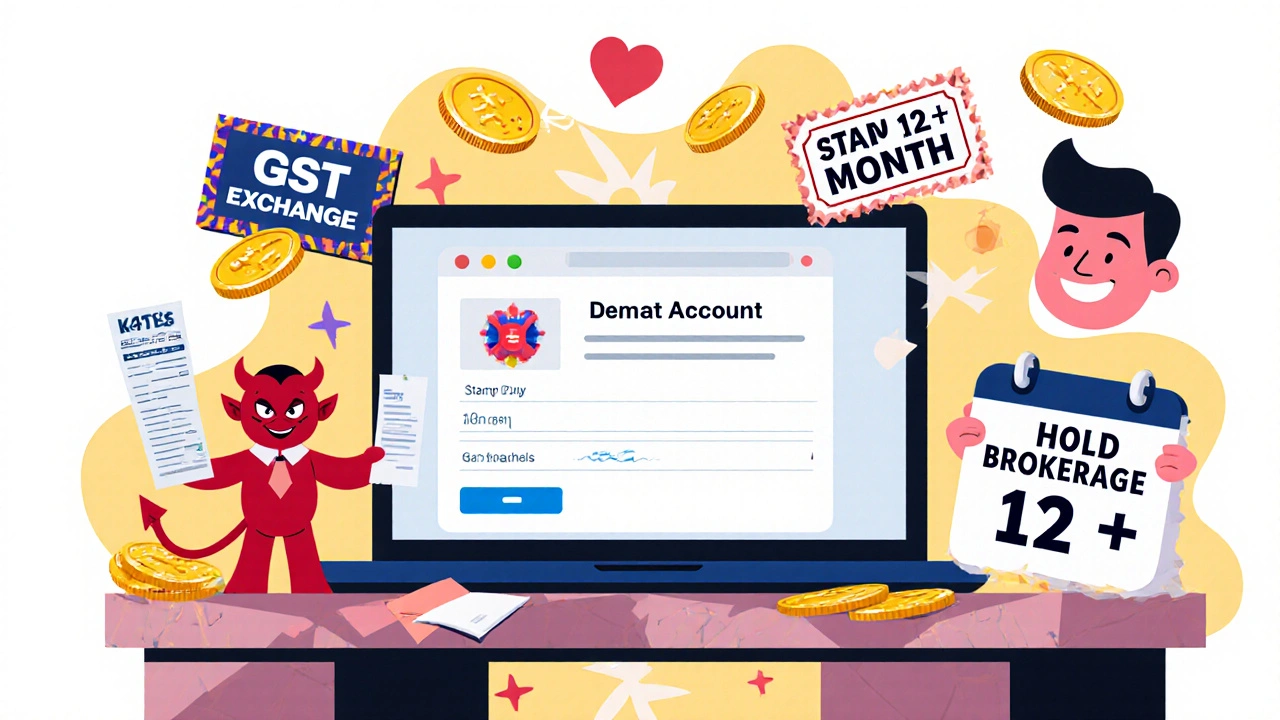STT, Stamp Duty, and Other Trading Taxes in India: What Equity Investors Actually Pay
 Nov, 8 2025
Nov, 8 2025
If you buy or sell stocks in India, you’re paying taxes-even if you didn’t realize it. Most new investors think the only cost is the brokerage fee. But hidden in every trade are taxes that eat into profits. The biggest ones? Securities Transaction Tax (STT), stamp duty, and capital gains tax. Together, they can add up to more than 0.5% of your trade value. That might sound small, but over time, it adds up fast.
What is STT and how does it work?
Securities Transaction Tax, or STT, is a tax charged by the Indian government on every trade made on a recognized stock exchange. It doesn’t matter if you’re buying or selling-STT applies to both. The rate changes depending on what you’re trading.
For equity delivery trades (buying shares to hold long-term), STT is 0.1% on the sale value. If you sell ₹100,000 worth of shares, you pay ₹100 in STT. For intraday trades (buying and selling the same day), STT is 0.025% on the sale value. That’s half the rate of delivery trades.
But here’s the catch: STT is not charged on the purchase side for intraday trades. Only on the sell side. So if you buy ₹50,000 of stock and sell it the same day, you pay STT only on the ₹50,000 sale, not the purchase. That’s why many day traders prefer intraday-it cuts their STT cost in half.
STT is collected automatically by your broker. You won’t see it as a separate line item on your contract note, but it’s there. If you’re tracking your true cost of trading, you need to factor it in. Many investors forget STT when calculating returns, which leads to overestimating profits.
Stamp duty: the tax you can’t avoid
Stamp duty is another tax that applies to every stock transaction in India. Unlike STT, stamp duty is charged on the purchase side only. It’s not a federal tax-it’s set by individual states. That means the rate changes depending on where your broker is registered.
As of 2025, most states charge 0.015% of the purchase value for equity delivery trades. So if you buy ₹200,000 of shares, you pay ₹30 in stamp duty. For derivatives like futures and options, the rate is higher: 0.003% on the contract value.
Some states, like Maharashtra and Karnataka, have raised stamp duty rates in recent years to boost revenue. Others, like Gujarat, keep it lower. But since brokers operate nationwide, they typically charge the highest applicable rate across states. That means even if you live in a state with low stamp duty, you’re likely paying the maximum rate because your broker is based elsewhere.
Stamp duty is non-negotiable. You can’t avoid it by using a different broker. It’s built into the system. And unlike brokerage fees, which can be negotiated or reduced with discount brokers, stamp duty is fixed by law. It’s one of the few trading costs you can’t shop around for.
Capital gains tax: the big one
Once you sell your shares and make a profit, you owe capital gains tax. This is where most investors get surprised. Many think if they don’t withdraw money from their account, they don’t owe tax. But that’s not true. The moment you sell at a profit, the tax liability kicks in.
There are two types: short-term and long-term capital gains. Short-term gains apply if you hold shares for less than 12 months. The tax rate is 15%. So if you buy shares for ₹1 lakh and sell them for ₹1.2 lakh after 6 months, your profit is ₹20,000. You pay ₹3,000 in tax.
Long-term gains apply if you hold shares for more than 12 months. The first ₹1 lakh of gains in a financial year is tax-free. Anything above that is taxed at 10%. So if you hold shares for 18 months and make ₹1.5 lakh in profit, you pay 10% on ₹50,000-that’s ₹5,000. No tax on the first ₹1 lakh.
There’s no indexation benefit for equity shares. That means you can’t adjust your purchase price for inflation. This makes long-term gains more expensive than they used to be. Before 2018, you could adjust for inflation and pay less tax. Now, you pay tax on the full nominal gain.
Dividends from Indian companies are also taxed. If you receive more than ₹5,000 in dividends in a year, the company deducts 10% TDS. You still need to report it in your income tax return. There’s no exemption for small investors.

Other hidden costs: exchange fees and GST
There’s more than just STT, stamp duty, and capital gains. Brokers also pass on exchange fees and GST to you. The National Stock Exchange (NSE) and Bombay Stock Exchange (BSE) charge small fees for each trade-usually ₹5 to ₹10 per contract. These are added to your bill.
Then there’s GST. Brokers charge 18% GST on their brokerage fees. So if your broker charges ₹20 per trade, you pay ₹3.60 in GST on top. That’s not a big amount for a single trade, but if you trade 10 times a week, that’s ₹180 a month in GST alone.
Some brokers advertise ‘zero brokerage’ for delivery trades. But even then, you still pay STT, stamp duty, exchange fees, and GST. That’s a marketing trick. You’re not avoiding taxes-you’re just paying them separately.
How much do you really pay per trade?
Let’s say you buy ₹1 lakh worth of shares and sell them 3 months later. Here’s what you pay:
- Stamp duty (purchase): 0.015% of ₹1,00,000 = ₹15
- STT (sale): 0.1% of ₹1,00,000 = ₹100
- Capital gains tax: 15% of ₹20,000 profit = ₹3,000
- Brokerage (if any): ₹20 (assumed)
- GST on brokerage: 18% of ₹20 = ₹3.60
- Exchange fees: ₹10 (estimated)
Total taxes and fees: ₹3,148.60
That’s 3.15% of your trade value. And you only made a 20% profit. So nearly 16% of your profit went to taxes and fees. If your profit was only ₹10,000, you’d pay ₹1,574 in taxes-over 15% of your gain.
Now imagine you trade monthly. Over a year, you make 12 trades. Even with modest gains, you could pay ₹30,000 or more in taxes. That’s why frequent trading kills returns for most retail investors.

How to reduce your tax burden
You can’t avoid STT or stamp duty. But you can manage capital gains tax smartly.
- Hold for over a year: Long-term gains have a ₹1 lakh exemption. Holding for 12+ months cuts your tax rate from 15% to 10% on gains above ₹1 lakh.
- Use your ₹1 lakh exemption: If you have multiple portfolios, sell enough each year to use up the ₹1 lakh exemption. Don’t let it expire.
- Avoid frequent trading: Day trading or swing trading increases your tax burden. Each trade adds STT, GST, and brokerage. You’re better off holding quality stocks long-term.
- Track your cost basis: Use a spreadsheet or app to track your purchase price and date. Mistakes here can lead to overpaying tax.
- Don’t chase tax-free tips: Some brokers push derivatives or futures claiming they’re tax-efficient. But they’re riskier and often cost more in fees. STT on futures is 0.003%, but your losses can be bigger.
What happens if you don’t pay?
The Income Tax Department tracks every trade. Brokers report all transactions to the tax authority. If you don’t declare capital gains, you’ll get a notice. Penalties can be up to 200% of the tax due. Interest accrues at 1% per month. In extreme cases, the department can freeze your bank account or demat account.
There’s no way to hide equity trades. Even if you use a foreign broker or crypto platform to buy Indian stocks, the tax department has agreements with global exchanges. They know.
Final takeaway
Trading taxes in India aren’t optional. They’re built into every transaction. Most investors don’t realize how much they’re paying until they look at their net returns. STT and stamp duty are small per trade, but they add up. Capital gains tax is the real killer.
If you’re serious about investing, treat taxes like part of your strategy. Don’t just pick stocks-plan when to sell. Hold for the long term. Use your ₹1 lakh exemption every year. Avoid unnecessary trades. The best investors aren’t the ones who trade the most. They’re the ones who pay the least in taxes while still growing their wealth.
Is STT charged on both buy and sell orders?
No. STT is charged only on the sale side for intraday trades. For delivery trades, it’s charged on the sale value only. You don’t pay STT when you buy shares.
Can I avoid stamp duty by using a different broker?
No. Stamp duty is set by state law and collected by the stock exchange. Even if you switch brokers, you’ll still pay the same rate because the exchange determines the rate based on where the trade is settled.
Are dividends taxed in India?
Yes. If you receive more than ₹5,000 in dividends in a financial year, the company deducts 10% TDS. You must report all dividends in your income tax return, even if TDS was deducted.
What’s the difference between short-term and long-term capital gains?
Short-term capital gains apply if you hold shares for less than 12 months and are taxed at 15%. Long-term gains apply if you hold for 12+ months. The first ₹1 lakh of profit is tax-free, and anything above is taxed at 10%.
Do I need to pay tax if I reinvest my profits?
Yes. Tax is triggered by the sale, not by whether you withdraw money. Reinvesting your profits into new stocks doesn’t delay or avoid capital gains tax. The moment you sell at a profit, you owe tax.
